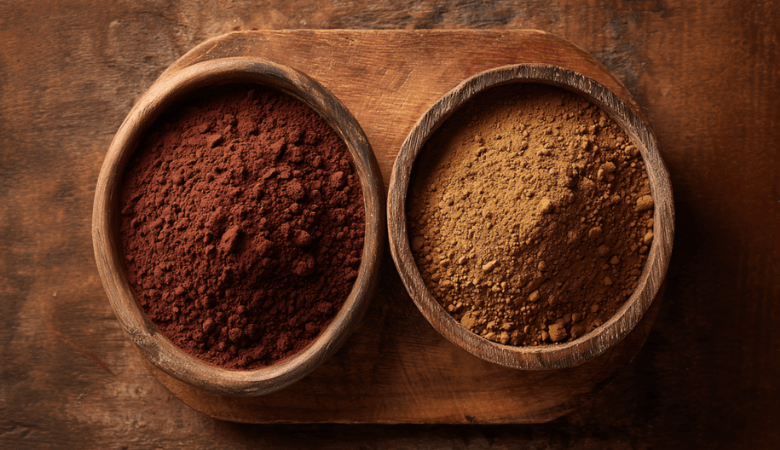
Alkalized vs Non-Alkalized Cocoa: Which Should You Choose?
|
|
Time to read 3 min
This store requires javascript to be enabled for some features to work correctly.
|
|
Time to read 3 min
When browsing the baking aisle, you’ve probably noticed two main types of cocoa powder: alkalized cocoa (Dutch-processed) and non-alkalized cocoa (natural cocoa powder).
Though they may look similar, their processing methods, flavors, and baking properties make them suited for different uses. Understanding alkalized cocoa vs non-alkalized ensures you choose the right cocoa powder for your recipes—and for many, Dutch-processed cocoa is the gold standard for both flavor and versatility.
Alkalized cocoa (Dutch-processed) offers smoother flavor, darker color, and greater versatility in baking and beverages.
It’s also easier on digestion, making it a practical choice for everyday use.
While non-alkalized cocoa has higher flavanols, most people prefer the taste, texture, and appearance of alkalized cocoa.
Alkalized cocoa, also called Dutch-processed cocoa, is made by treating cocoa beans with a mild alkali solution to reduce acidity. This changes its pH balance, giving it a smoother flavor and deeper color.
pH: Around 6.8–8 (neutral to slightly alkaline)
Color: Darker, richer, and more visually appealing
Flavor: Mellow, smooth, less bitter, with a luxurious depth
Common uses: Premium desserts, European-style chocolate, hot cocoa mixes, and recipes requiring baking powder
Because of its balanced pH and refined taste, alkalized cocoa is the go-to choice for rich, indulgent chocolate experiences.
Non-alkalized cocoa, often labeled as natural cocoa powder, is made by pressing roasted cocoa beans without altering their natural acidity.
pH: Around 5–6 (naturally acidic)
Color: Lighter brown
Flavor: Sharper, more bitter, and slightly fruity
Common uses: Traditional recipes that rely on acidity, such as classic American cakes and brownies with baking soda
While natural cocoa offers a bold flavor, its acidity can limit its versatility in both baking and beverages.
Alkalized: Smoothed and refined for balance, making it versatile in both sweet and savory applications.
Non-alkalized: Minimal processing, leaving higher acidity and a sharper taste.
Alkalized: Smooth, mellow, luxurious taste—perfect for gourmet desserts and hot drinks.
Non-alkalized: Tangy, bold, and more bitter—better for those who like intense flavors.
Alkalized: Deep, rich chocolate brown, enhancing the look of cakes, cookies, and drinks.
Non-alkalized: Light brown, less dramatic visually.
Alkalized: Still contains antioxidants, magnesium, and iron. Easier on the stomach thanks to reduced acidity.
Non-alkalized: Higher in flavanols but also sharper in taste—making it less appealing to some palates.
Alkalized cocoa pairs perfectly with baking powder, offering consistent results.
Non-alkalized cocoa requires baking soda to balance its acidity.
Cocoa in any form is a source of antioxidants, minerals, and mood-enhancing compounds. The difference lies in taste and digestibility:
Alkalized cocoa: Easier on digestion, less acidic, and favored for its silky flavor and recipe flexibility.
Non-alkalized cocoa: Retains slightly higher antioxidant levels but can taste harsh or bitter in comparison.
For most, the enjoyment and everyday usability of Dutch-processed cocoa make it the more practical and appealing choice.
If you want consistent results and indulgent flavor, alkalized cocoa is the better option. It blends smoothly into recipes, produces a deeper chocolate color, and creates desserts that taste more refined.
Choose alkalized (Dutch-processed): When making European-style desserts, hot chocolate, gourmet cakes, or any recipe where smooth flavor matters.
Choose non-alkalized (natural): When following older recipes that specifically call for it, especially those using baking soda.
When it comes to hot chocolate, the choice is clear:
Alkalized cocoa: Smooth, rich, and luxurious—exactly what you expect in a decadent cup.
Non-alkalized cocoa: Tangier, more bitter—better for those who enjoy a sharper, old-fashioned style of cocoa.
Both are healthy, but alkalized cocoa is gentler on digestion and delivers a smoother, more enjoyable chocolate experience.
It retains slightly more flavanols and offers a bolder, tangier taste—though it’s less versatile in recipes.
Both provide minerals and antioxidants. The healthiest choice is the one you’ll enjoy and use regularly—many people prefer alkalized cocoa because it’s more palatable.
Not at all. Dutch processing improves flavor, reduces bitterness, and makes cocoa easier to use in recipes while still retaining nutritional benefits.
Yes, but keep in mind the leavening agent. Dutch-processed cocoa works best with baking powder, while natural cocoa pairs with baking soda.
Most people prefer alkalized cocoa for its smooth, rich, indulgent taste in hot chocolate.